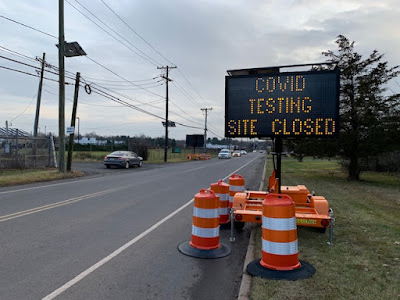The outcome
ModernaTx, Inc. (“Moderna”) appeals from the decision
of the U.S. Patent and Trademark Office Patent Trial and
Appeal Board (the “Board”) holding that the claims of U.S.
Patent 8,058,069 (“’069 patent”) are not unpatentable as
obvious. See Moderna Therapeutics, Inc. v. Protiva Biotherapeutics, Inc., IPR2019-00554, 2020 WL 4237232 (July
23, 2020) (“Board Decision”). For the reasons provided below, we affirm
There is a companion decision by the CAFC, released the same day,
on a different patent:
ModernaTx, Inc. (“Moderna”) appeals from the decision
of the U.S. Patent and Trademark Office Patent Trial and
Appeal Board (“Board”) holding that claims 7–8, 10–11, 13,
and 16–20 of U.S. Patent 9,364,435 are not unpatentable
as obvious. See Moderna Therapeutics, Inc. v. Protiva Biotherapeutics, Inc., IPR2018-00739, 2019 Pat. App. LEXIS
13612 (Sept. 11, 2019) (“Board Decision”).
The case on the '435 patent was decided solely on lack of standing.
The case of the '069 patent was NOT so decided.
From the case on the '069 patent:
Before we consider Moderna’s argument on the merits
of the Board’s decision upholding the claims of the ’069 patent, we must first determine whether Moderna has standing to pursue its appeal. After all, “no principle is more
fundamental to the judiciary’s proper role in our system of
government than the constitutional limitation of federalcourt jurisdiction to actual cases or controversies.” DaimlerChrysler Corp. v. Cuno, 547 U.S. 332, 341–42 (2006)
(quoting Raines v. Byrd, 521 U.S. 811, 818 (1997)).
(...)
We have held that an appellant “need not face ‘a specific threat of infringement litigation by the patentee’ to establish the requisite injury in an appeal from a final
written decision in an inter partes review.” Adidas AG v.
Nike, Inc., 963 F.3d 1355, 1357 (Fed. Cir. 2020) (quoting
DuPont, 904 F.3d at 1004). Instead, “it is generally sufficient for the appellant to show that it has engaged in, is
engaging in, or will likely engage in ‘activity that would
give rise to a possible infringement suit.’” Grit Energy
Sols., LLC v. Oren Techs., LLC, 957 F.3d 1309, 1319 (Fed.
Cir. 2020) (quoting Consumer Watchdog, 753 F.3d at 1262).
Accordingly, on the record before us, Moderna has demonstrated enough of a risk that it will be faced with an infringement suit based on the combination of its own
activities in developing the COVID-19 vaccine, Arbutus’s
broad public statements about its extensive patent coverage in this area, and Arbutus’s refusal to grant a covenant
not to sue.
It also bears noting that, if we were to dismiss this appeal for lack of standing, Arbutus could sue Moderna for
infringement immediately thereafter. That possibility is
easy to envision based on the record, and Arbutus has done
nothing to dispel it. We seek to avoid such a result, which
would perversely incentivize a future similarly situated patent owner to remain silent regarding its intentions during
the pendency of an appeal and wait to sue for infringement
until after the appeal has been dismissed for lack of standing.
For the foregoing reasons, we conclude that Moderna
has standing to pursue its appeal based on the risk of an
infringement suit, and we proceed to the merits of this appeal.
Of optimizing result-effective variables:
It has long been established law that “where the general conditions of a claim are disclosed in the prior art, it is
not inventive to discover the optimum or workable ranges
by routine experimentation.” In re Aller, 220 F.2d 454, 456
(C.C.P.A. 1955). It is also well-established that “the parameter to be optimized must have been recognized by
those skilled in the art to be a ‘result-effective variable.’”
In re Antoine, 559 F.2d 618, 620 (C.C.P.A. 1977). But, more
recently, we clarified that in cases with multiple result-effective variables, “[e]vidence that the variables interacted
in an unpredictable or unexpected way could render the
combination nonobvious.” Applied Materials, 692 F.3d at
1298.
It cannot be disputed that the general conditions for a
nucleic acid-lipid particle were disclosed in the prior art.
Specifically, the ’196 PCT and the ’189 publication disclose
particles that contain all four of the lipid components recited in the claims of the ’069 patent. Moderna argues that
it presented sufficient evidence that the disclosures in
those references presented a starting point that would have
allowed a person of ordinary skill in the art to arrive at the
claimed invention through routine optimization.
(...)
Moderna provided evidence of general considerations
to be taken into account with respect to each individual
component. But Moderna’s evidence failed to address the
interdependence of the claimed lipid components and how
adjustments would affect the nucleic acid-lipid particle as
a whole. See Board Decision, 2020 WL 4237232, at *15. As
one example, the Board considered Moderna’s general evidence that high cationic lipid amounts and low phospholipid amounts would be desirable, but the Board was
unpersuaded in part because the ’196 PCT and the
’189 publication also suggested that lower amounts of cationic lipids and higher amounts of phospholipid would be
acceptable. See id. Ultimately, substantial evidence—including the prior art and expert testimony—supports the
Board’s finding that optimizing the four interdependent lipid components in the prior art nucleic acid-lipid particles
would not have been routine, and Moderna’s proposed adjustments to the various lipid components are hindsight
driven. See id. The unpredictable interactivity between
the various lipid components renders the claims of the ’069
nonobvious. See Applied Materials, 692 F.3d at 1298





